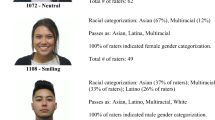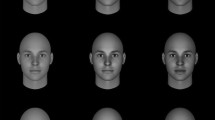Abstract
This research utilized a novel methodology to explore the relative salience of facial cues to age, sex, race, and emotion in differentiating faces. Inspired by the Stroop interference effect, participants viewed pairs of schematic faces on a computer that differed simultaneously along two facial dimensions (e.g., race and age) and were prompted to make similarity judgments about the faces along one of the dimensions (e.g., race). On a second round of trials, judgments were made along the other dimension (e.g., age). Analysis of response speed and accuracy revealed that participants judged the race of the faces more quickly and with fewer errors compared to their age, gender, or emotional expression. Methodological and theoretical implications for studying the role of facial cues in social perception are discussed.
Similar content being viewed by others
References
Bargh, J. A., Chaiken, S., Govender, R., & Pratto, F. (1992). The generality of the automatic attitude activation effect. Journal of Personality and Social Psychology, 62, 893-912.
Brewer, M. (1988). A dual processing model of impression formation. In T. K. Srull & R. S. Wyer (Eds.), Advances in social cognition (pp. 1-36). Hillsdale, NJ: Erlbaum.
Brewer, M., & Lui, L. (1989). The primacy of age and sex in the structure of person categories. Social Cognition, 7, 262-274.
Bruce, V. (1988). Recognizing faces. Hillsdale, NJ: Erlbaum.
Bruce, V., & Burton, M. (1992). Processing images of faces. New Jersey: Ablex.
Bruce, V., & Young, A. (1998). In the eye of the beholder: The science of face perception. New York: Oxford University Press.
Bruyer, R. (1986). The neuropsychology of face perception and facial expression. Hillsdale, NJ: Erlbaum.
Busey, T. A. (1998). Physical and psychological representations of faces: Evidence from morphing. Psychological Science, 9, 476-483.
Campbell, R., Benson, P. J., Wallace, S. B., Doesbergh, S., & Coleman, M. (1999). More about brows: How poses that change brow position affect perceptions of gender. Perception, 28, 489-504.
Carroll, J. M., & Russell, J. A. (1996). Do facial expressions signal specific emotions? Judging emotion from the face in context. Journal of Personality and Social Psychology, 70, 205-218.
Devine, P. G. (1989). Stereotypes and prejudice: Their automatic and controlled components. Journal of Personality and Social Psychology, 56, 5-18.
Ekman, P., & Friesen, W. V. (1975). Unmasking the face. Englewood Cliffs, NJ: Prentice-Hall.
Fiske, S., & Neuberg, S. L. (1990). A continuum of impression formation from category-based to individuating process: Influences of information and motivation on attention and interpretation. In M. Zanna (Ed.), Advances in Experimental Social Psychology (Vol 23, pp. 1-74). New York: Academic Press.
Gilbert, D. T., & Jones, E. E. (1986). Perceiver-induced constraint: Interpretations of self-generated reality. Journal of Personality and Social Psychology, 50, 269-280.
Gilbert, D. T., Pelham, B. W., & Krull, D. S. (1988). On cognitive busyness: When person perceivers meet persons perceived. Journal of Personality and Social Psychology, 54, 733-740.
Greenwald, A. G., & Banaji, M. R. (1995). Implicit social cognition: Attitudes, self-esteem, and stereotypes. Psychological Review, 102, 4-27.
Greenwald, A. G., McGhee, D. E., & Schwartz, J. L. K. (1998). Measuring individual differences in implicit cognition: The implicit association test. Journal of Personality and Social Psychology, 74, 1464-1480.
Hansen, C. H., & Hansen, R. D. (1988). Finding the face in the crowd: An anger superiority effect. Journal of Personality and Social Psychology, 54, 917-924.
Intons-Peterson, M. J. (1988). Children's concepts of gender. Norwood, NJ: Ablex Publishing.
Kogan, N. (1979). A study of age categorization. Journal of Gerontology, 34, 358-367.
LaPlante, D., & Ambady, N. (2000). Multiple messages: Facial recognition advantage for compound expressions. Journal of Nonverbal Behavior, 24, 211-224.
Lewis, M., & Brooks-Gunn, J. (1979). Social cognition and the acquisition of self. New York: Plenum.
Mackie, D. M., Hamilton, D. L., Susskind, J., & Rosselli, F. (1996). Social psychological foundations of stereotype formation. In C. N, Macrae, C. Stangor, & M. Hewstone (Eds.), Stereotypes and stereotyping (pp. 41-48). New York: Guilford.
MacLeod, C. (1991). Half a century of research on the Stroop effect: An integrative review. Psychological Bulletin, 109, 163-203.
McArthur, L. Z., & Baron, R. M. (1983). Toward an ecological theory of social perception. Psychological Review, 90, 215-238.
McGraw, K. O., Durm, M. W., & Durnam, M. R. (1989). The relative salience of sex, race, age, and glasses in children's social perceptions. Journal of Genetic Psychology, 150, 251-267.
McNeill, D. (1998). The face. New York: Little, Brown, and Company.
Milord, J. T. (1978). Aesthetic aspects of faces: A (somewhat) phenomenological analysis using multidimensional scaling methods. Journal of Personality and Social Psychology, 36, 205-216.
Mondloch, C. J., Lewis, T. L., Budreau, D. R., Maurer, D., Dannemiller, J. L., Stephens, B. R., & Kleiner-Gathercoal, K. A. (1999). Face perception during early infancy. Psychological Science, 10, 419-422.
Montepare, J. M., & Zebrowitz, L. A. (1998). “Person perception comes of age”: The salience and significance of age in social judgments. In M. Zanna (Ed.), Advances in Experimental Social Psychology (Vol. 30, pp. 93-161), San Diego, CA: Academic Press.
Montepare, J. M., & Zebrowitz, L. A. (2002, in press). A social-developmental view of ageism. In T. Nelson (Ed.), Ageism: Stereotyping and prejudice against older persons. Cambridge: MIT Press.
Nelson, C. A. (1987). The recognition of facial expressions the first two years of life: Mechanisms of development. Child Development, 58, 889-909.
Rhodes, G. (1996). Superportraits: Caricature and recognition. Hove: Psychology Press.
Shepherd, J., Davies, G., & Ellis, H. (1981). Studies of cue salience. In G. Davies, H. Ellis, & J. Shepherd (Eds.), Perceiving and remembering faces (pp. 105-131). London: Academic Press.
Smith, E., & Zarate, M. A. (1992). Exemplar-based model of social judgment. Psychological Review, 99, 3-21.
Stangor, C., Lynch, L., Duan, C., & Glass, B. (1992). Categorization of individuals on the basis of multiple social features. Journal of Personality and Social Psychology, 62, 207-218.
Stroop, J. R. (1935). Studies of interference in serial verbal reactions. Journal of Experimental Psychology, 18, 643-662.
Zarate, M. A., & Smith, E. R. (1990). Person categorization and stereotyping. Social Cognition, 8, 161-185.
Zebrowitz, L. A. (1997). Reading faces. Boulder, CO: Westview Press.
Zebrowitz, L. A., Montepare, J. M., & Lee, H. K. (1993). They don't all look alike: Individuated impressions of other racial groups. Journal of Personality and Social Psychology, 65, 85-101.
Author information
Authors and Affiliations
Corresponding author
Rights and permissions
About this article
Cite this article
Montepare, J.M., Opeyo, A. The Relative Salience of Physiognomic Cues in Differentiating Faces: A Methodological Tool. Journal of Nonverbal Behavior 26, 43–59 (2002). https://doi.org/10.1023/A:1014470520593
Issue Date:
DOI: https://doi.org/10.1023/A:1014470520593




